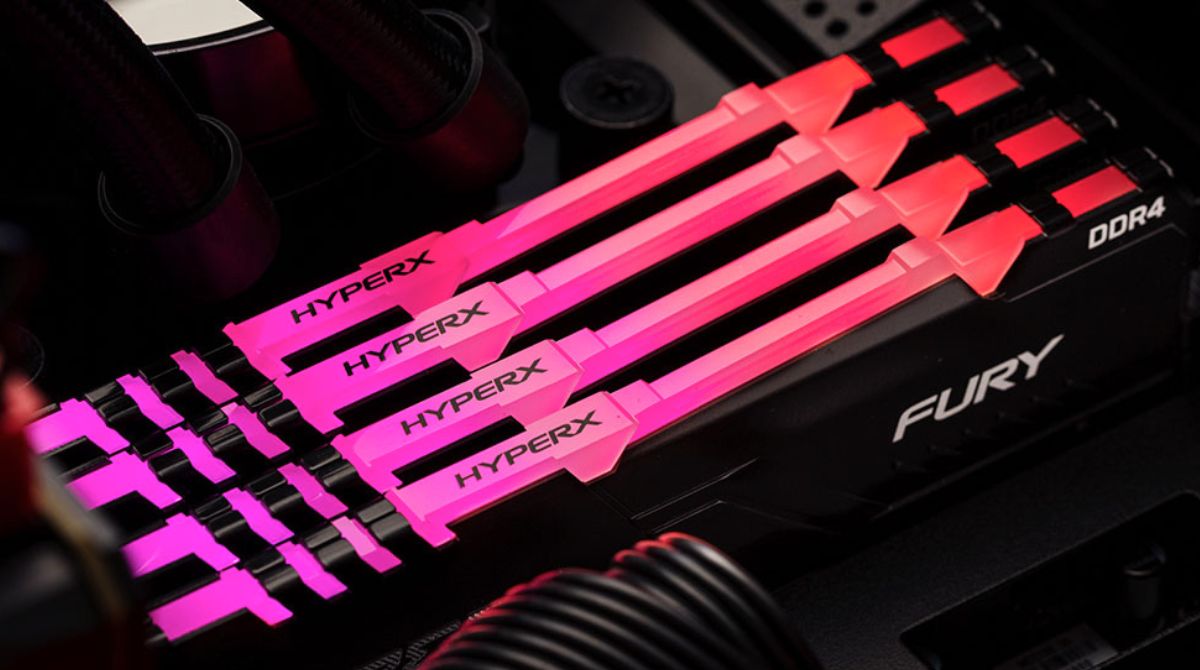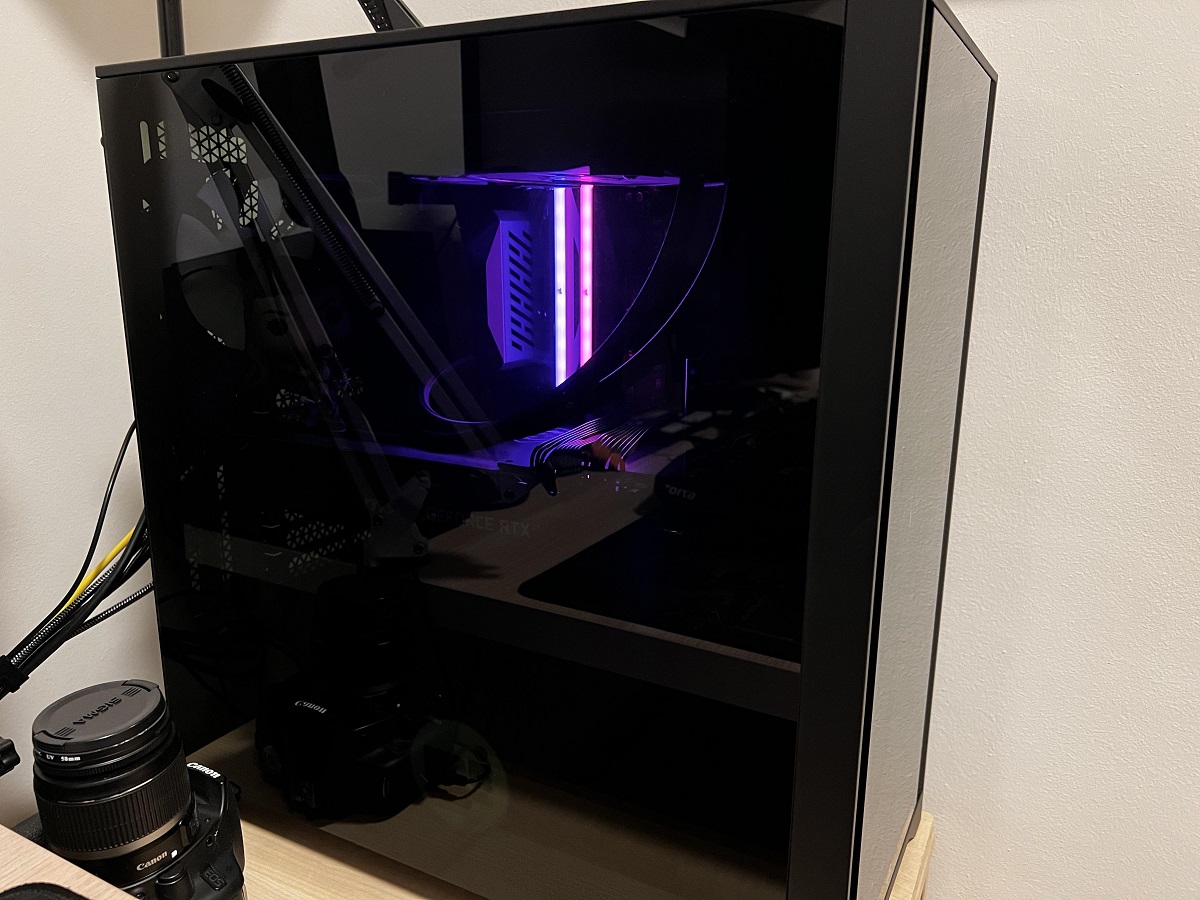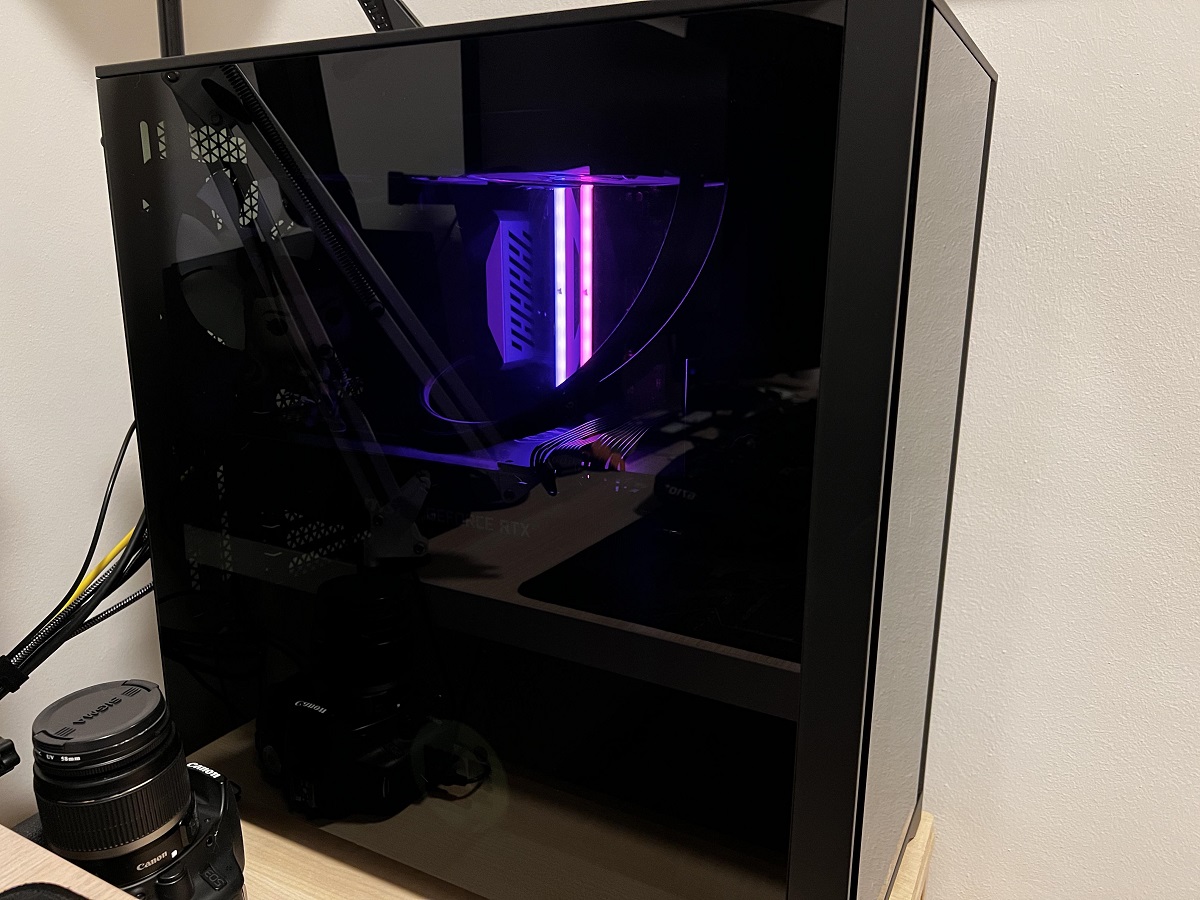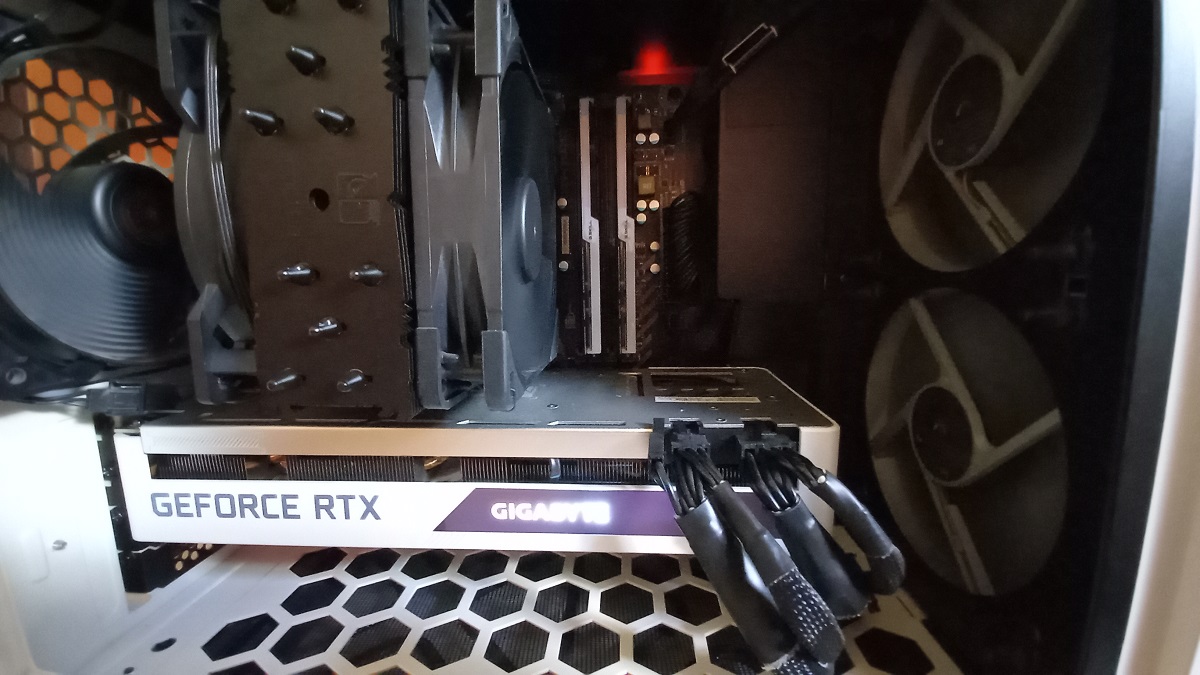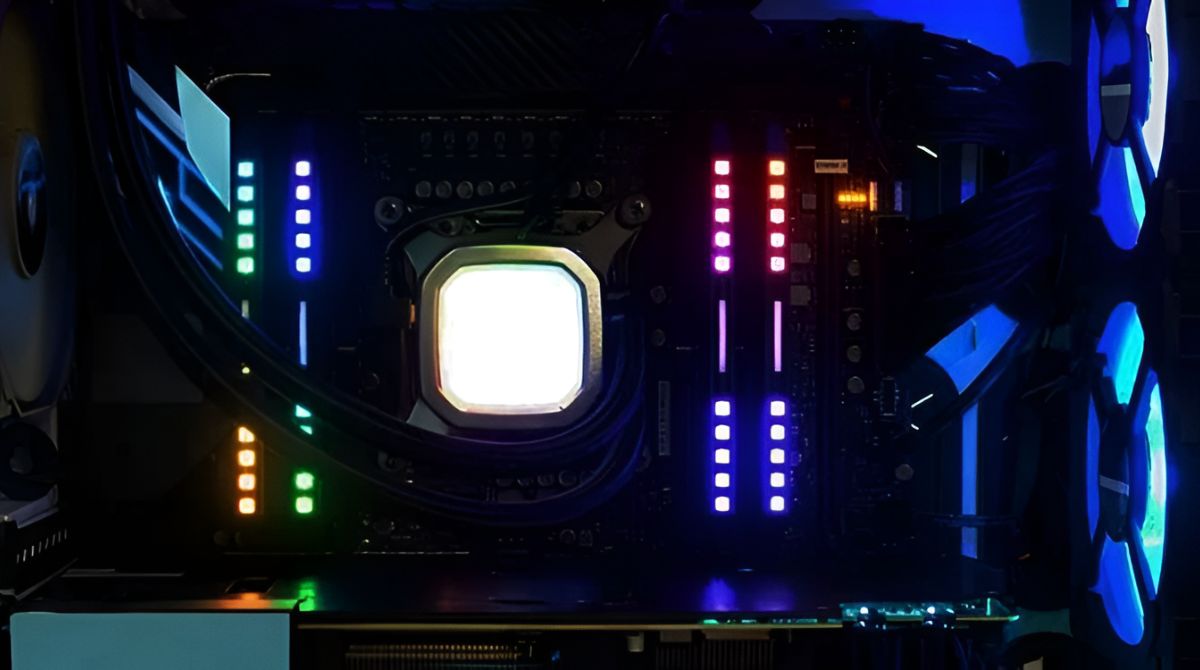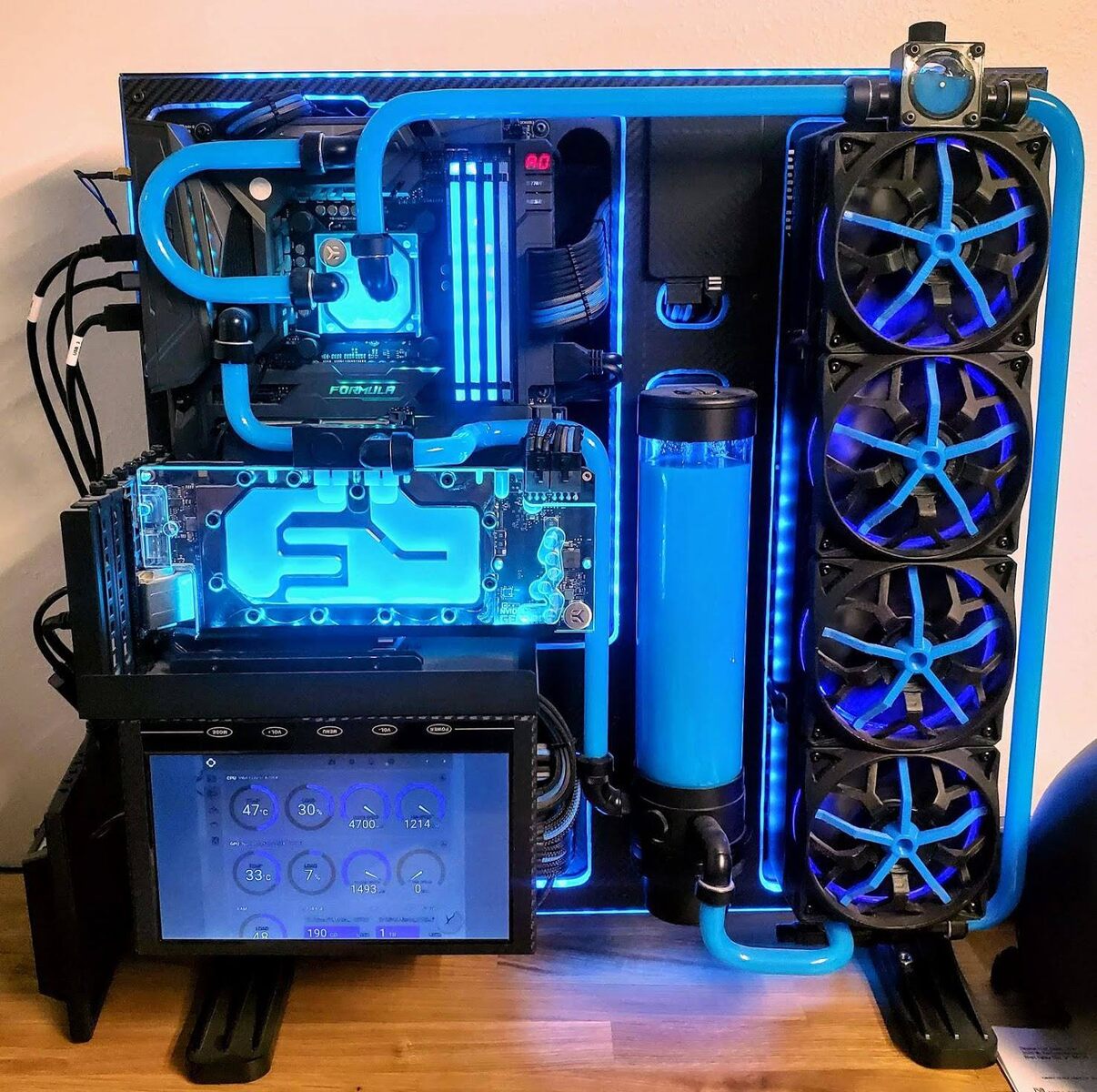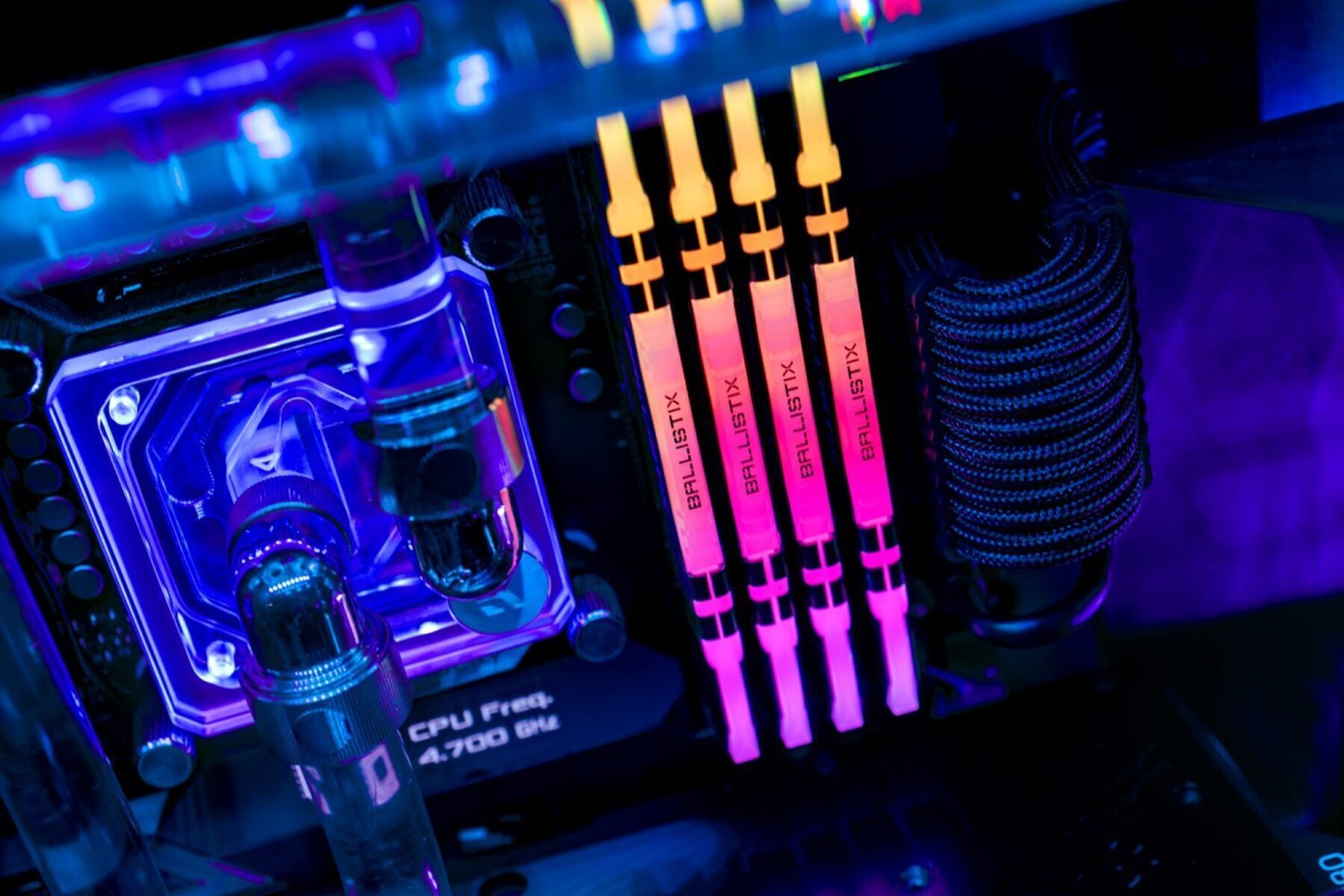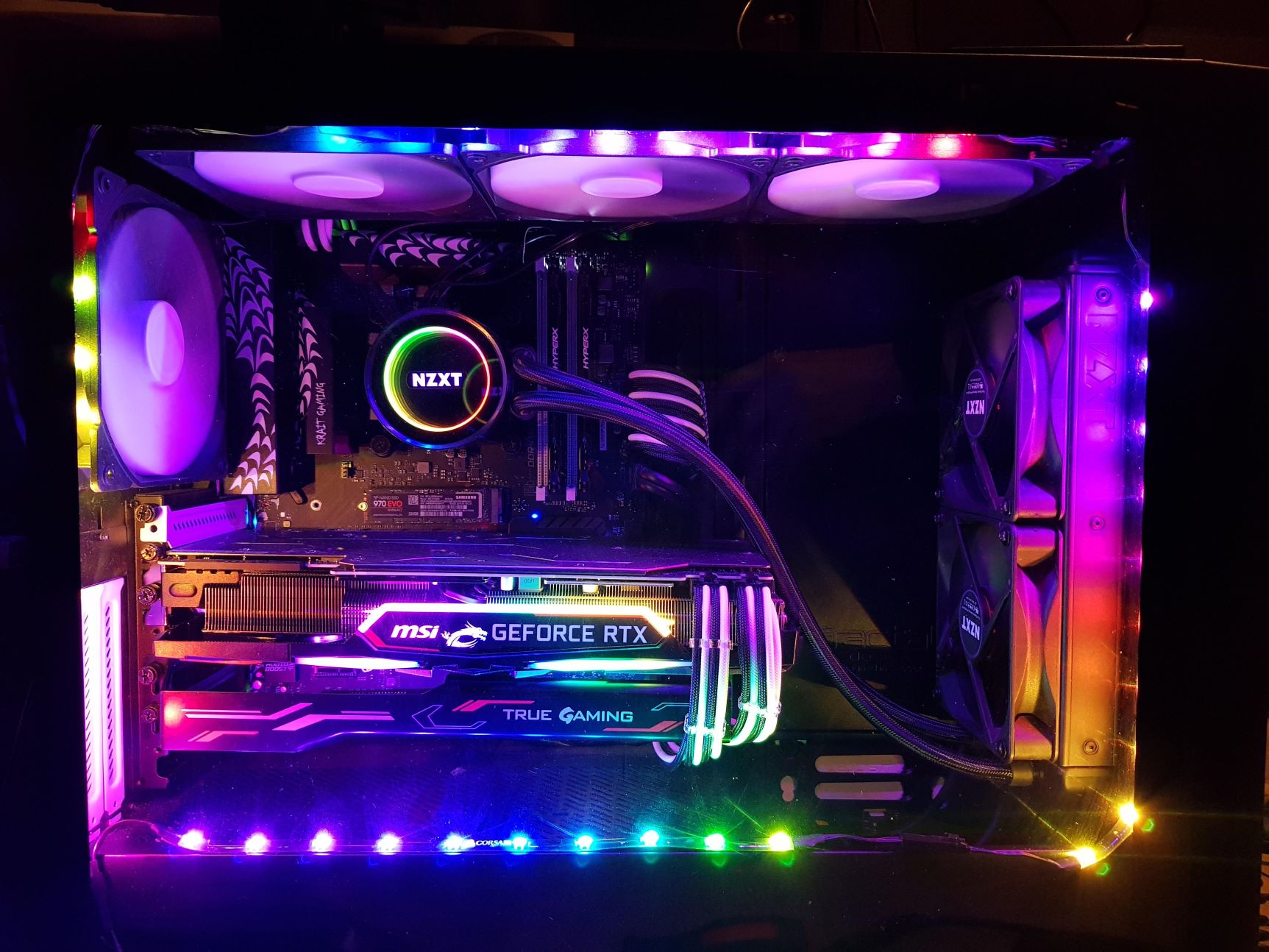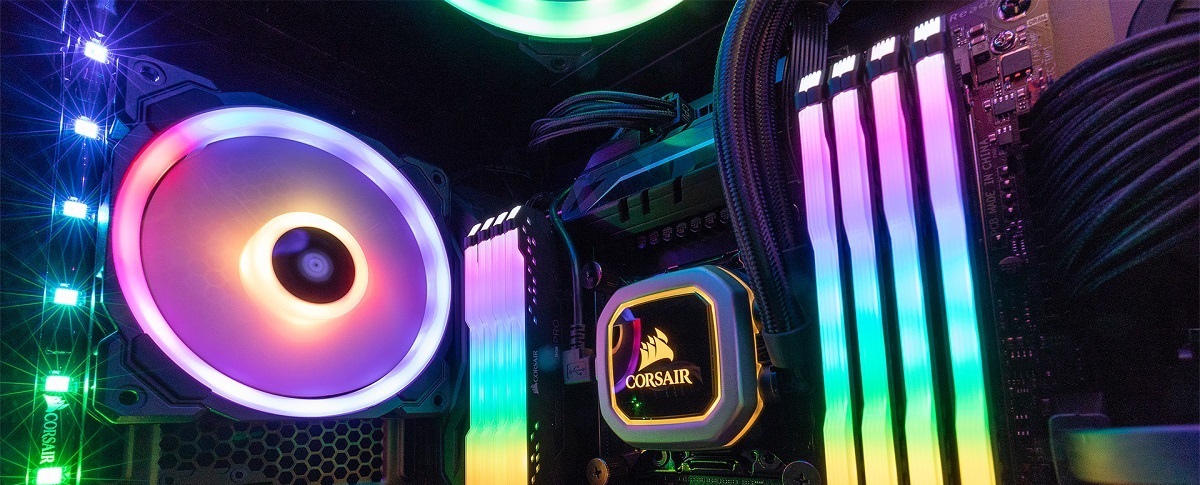Introduction
Welcome to the world of RGB on RAM. In today’s tech-savvy era, computer customization has reached new heights, allowing users to personalize every aspect of their devices. One such popular trend is RGB lighting, which brings a vibrant and visually captivating experience to any gaming or PC setup.
RGB stands for Red, Green, Blue, referring to the primary colors used to create a wide range of hues. This dynamic lighting technology has evolved beyond just keyboard backlighting and has now made its way to RAM modules. RAM, or Random Access Memory, plays a crucial role in the performance of a computer, and with the addition of RGB lighting, it not only enhances functionality but also adds an eye-catching aesthetic appeal.
Controlling RGB on RAM allows users to unleash their creativity and personalize their computer’s appearance. With the ability to adjust colors, patterns, and effects, users can completely transform the look and feel of their system to match their unique style and taste.
If you’re wondering how to control RGB on RAM, you’ve come to the right place. In this article, we will provide you with a step-by-step guide on how to control RGB on RAM, ensuring that you can make the most out of this exciting feature.
What is RGB on RAM?
RGB on RAM refers to the integration of RGB lighting technology into the modules of Random Access Memory, which is a vital component in any computer system. Traditionally, RAM modules were designed purely for functionality, with no focus on aesthetics. However, with the rise of RGB lighting, RAM modules now offer a visually striking upgrade to any computer setup.
The RGB lighting on RAM modules consists of small LED lights embedded on the surface of the modules. These lights emit vibrant colors and can be customized to create mesmerizing lighting effects. Users can choose from a wide range of colors and dynamic patterns, allowing for endless customization options.
One of the key advantages of RGB on RAM is the ability to synchronize lighting effects across various components in a computer system. Many RGB control software, such as ASUS Aura Sync and Corsair iCUE, offer compatibility with other RGB-enabled components like motherboards, graphics cards, and fans. This synchronization creates a visually cohesive experience, enhancing the overall aesthetics of the PC.
Additionally, RGB on RAM provides an opportunity to showcase personal style and creativity. Whether you prefer a sleek and minimalistic setup or a bold and colorful one, the customizable RGB lighting allows you to tailor your RAM modules to match your desired aesthetic. From pulsating color gradients to vibrant wave effects, there are endless possibilities to explore and experiment with.
It’s important to note that RGB lighting on RAM does not affect the performance or functionality of the modules. The primary purpose of RAM is still to provide fast and efficient storage for data, while the RGB lighting adds a visually appealing touch. So you can enjoy the best of both worlds – exceptional performance and stunning aesthetics.
Why control RGB on RAM?
The ability to control RGB on RAM offers several benefits and reasons why it has become such a popular trend among PC enthusiasts. Let’s explore some of the reasons why controlling RGB on RAM is worth considering:
- Personalization: Controlling RGB on RAM allows you to personalize your computer setup and make it unique to your style. With a wide range of colors, patterns, and lighting effects to choose from, you can create a setup that reflects your personality and preferences.
- Aesthetic appeal: RGB lighting adds a visually captivating element to your computer. The vibrant colors and dynamic lighting effects create a visually stunning experience that enhances the overall aesthetics of your PC setup. It can completely transform the look and feel of your system, making it stand out from the crowd.
- Customization: RGB control software provides extensive customization options, allowing you to fine-tune the lighting effects on your RAM modules. You can control the brightness, speed, and color of the lighting, as well as create your own unique lighting profiles. This level of customization ensures that your RGB setup is tailored to your exact preferences.
- Mood enhancement: RGB lighting has the power to set the mood and create an immersive gaming or working environment. Whether you want a calming ambiance with soft colors or an energetic atmosphere with pulsating lights, controlling RGB on RAM allows you to create the perfect setting for any activity.
- Synchronization: Many RGB control software offer synchronization capabilities, allowing you to harmonize the lighting effects across multiple components in your computer. This synchronization creates a visually cohesive experience and adds an extra layer of sophistication to your setup.
- Showcasing your build: If you’ve put in the effort to build a high-performance gaming rig or a visually impressive PC, why not show it off? Controlling RGB on RAM allows you to highlight your system’s unique features and draw attention to your craftsmanship.
With all these advantages, it’s no wonder why controlling RGB on RAM has gained such popularity. Not only does it enhance the overall aesthetics of your computer, but it also provides a fun and creative way to personalize your setup. So go ahead and take control of the RGB on your RAM, and let your imagination run wild!
How to Control RGB on RAM: Step-by-Step Guide
If you’re excited to control the RGB lighting on your RAM modules, follow this step-by-step guide to ensure a seamless and hassle-free experience:
- Step 1: Check compatibility
- Step 2: Install RGB control software
- Step 3: Open RGB control software
- Step 4: Customize RGB settings
- Step 5: Save and apply changes
Before diving into RGB control, it’s essential to check if your RAM modules support RGB lighting and if they are compatible with RGB control software. Consult the manufacturer’s documentation or visit their website to verify compatibility.
Next, download and install the RGB control software that corresponds to your RAM modules. Popular software options include ASUS Aura Sync, Corsair iCUE, and G.Skill TridentZ RGB Control. Visit the manufacturer’s website to find the latest version of the software.
Launch the RGB control software after the installation process is complete. You may need to grant necessary permissions or provide administrative access if prompted.
Once the software is open, you will be presented with options to customize the RGB lighting on your RAM modules. Explore the interface and locate the settings related to RAM or memory. Here, you can adjust colors, effects, patterns, and brightness to your liking. Some software may even offer advanced options such as individual LED control.
After customizing the RGB settings, make sure to save the changes. Depending on the software, you might have options to create and save different lighting profiles. Apply the changes to your RAM modules, and the new lighting effects will take effect immediately.
And that’s it! By following these simple steps, you can take full control of the RGB lighting on your RAM modules and create a visually stunning and personalized computer setup.
Step 1: Check Compatibility
Before you begin controlling the RGB lighting on your RAM modules, it’s essential to check for compatibility. Ensuring that your RAM modules support RGB lighting and are compatible with RGB control software will save you from any potential frustrations or incompatibility issues. Follow these steps to check the compatibility:
- Check your RAM module’s documentation: Start by referring to the documentation that came with your RAM modules. Look for any indications or specifications regarding RGB lighting support.
- Visit the manufacturer’s website: If you don’t have the documentation or if it doesn’t provide clear information, visit the manufacturer’s website. Most RAM manufacturers have a dedicated support page where you can find detailed information about the compatibility of their RAM modules with RGB lighting and control software.
- Check the software compatibility: Once you have confirmed that your RAM modules support RGB lighting, make sure to check if they are compatible with your chosen RGB control software. Visit the software manufacturer’s website and look for a list of supported RAM models or compatibility information. It’s important to note that not all software supports every RAM model, so double-checking compatibility is crucial.
- Consider motherboard compatibility: In some cases, compatibility with RGB control software may also depend on the motherboard you are using. Check if your motherboard supports the RGB control software you intend to use, as well as if it offers RGB headers or connectors for the RAM modules. Compatibility between the motherboard, RAM modules, and RGB control software is vital for a seamless RGB control experience.
- Consult online forums and communities: If you’re still unsure about compatibility or if you can’t find the necessary information on the manufacturer’s website, consider seeking help from online forums or communities dedicated to PC building and customization. Fellow enthusiasts and experts can provide valuable insights and guidance based on their experiences.
By carefully checking the compatibility of your RAM modules with RGB lighting and control software, you can ensure that you have all the necessary components and software to control the RGB lighting seamlessly. This initial step will save you time and frustration later on and allow you to proceed with confidence in customizing the RGB lighting on your RAM modules.
Step 2: Install RGB Control Software
Once you have confirmed compatibility between your RAM modules and RGB lighting, it’s time to install the RGB control software. The control software is essential for managing and customizing the RGB lighting on your RAM modules. Follow these steps to install the RGB control software:
- Research and select the appropriate software: Identify the RGB control software that is compatible with your RAM modules. Popular options include ASUS Aura Sync, Corsair iCUE, G.Skill TridentZ RGB Control, and more. Visit the manufacturer’s website or trusted online sources to download the latest version of the software.
- Download the software: Once you have chosen the RGB control software, navigate to the manufacturer’s website and locate the download section. Look for the version that corresponds to your operating system. Click on the download link to start the download process. Depending on the software, you may need to create an account or provide your email address to access the download.
- Install the software: Once the download is complete, locate the downloaded file and double-click on it to launch the installer. Follow the on-screen instructions to guide you through the installation process. You may be prompted to choose an installation location and configure additional settings, such as launching the software on startup. Make sure to read each step carefully and make the appropriate selections.
- Complete the installation: After the installation process is complete, you may need to restart your computer to ensure that the software is properly installed and ready to use. Follow any prompts that appear on the screen and restart your computer if required.
- Launch the RGB control software: Once your computer boots up, locate the installed RGB control software in your Start menu or desktop. Double-click on the software icon to launch it. Wait for the software to initialize and load all the necessary components.
After completing these steps, you will have the RGB control software installed on your computer. You are now ready to proceed with controlling and customizing the RGB lighting on your RAM modules. Move on to the next step to learn how to customize the RGB settings using the control software.
Step 3: Open RGB Control Software
Now that you have successfully installed the RGB control software for your RAM modules, it’s time to open the software and explore its features. Opening the RGB control software allows you to access the settings and customization options for your RAM’s RGB lighting. Follow these steps to open the RGB control software:
- Locate the software icon: Look for the RGB control software icon on your desktop, taskbar, or Start menu. The icon may vary depending on the software you are using, but it is usually a recognizable symbol associated with RGB lighting.
- Double-click to launch the software: Once you’ve located the software icon, double-click on it to launch the application. The software may take a few moments to load, depending on your computer’s speed and the complexity of the software.
- Grant necessary permissions: In some cases, the software may require administrative permissions or permissions to access certain settings on your computer. If prompted, grant the necessary permissions to ensure that the software can function properly.
- Wait for the software to initialize: Once launched, the RGB control software will initialize and establish communication with your RAM modules. This process may take a few seconds to a minute, depending on the software and the number of RGB-enabled components connected to your system.
After completing these steps, the RGB control software should be successfully opened and ready for customization. You will now have access to a variety of settings and options to adjust the RGB lighting on your RAM modules according to your preferences. Proceed to the next step to learn how to customize the RGB settings and create stunning lighting effects.
Step 4: Customize RGB Settings
With the RGB control software open, you can now dive into the exciting world of customizing the RGB settings for your RAM modules. This step allows you to unleash your creativity and personalize the lighting effects according to your preferences. Follow these steps to customize the RGB settings:
- Explore the software interface: Take a moment to familiarize yourself with the software interface. Different RGB control software may have varying layouts and options. Look for tabs, menus, or sections specifically related to RAM or memory RGB settings.
- Select RAM modules: Depending on the software, you may need to select the specific RAM modules you want to customize. If your computer has multiple RAM modules, you might be able to control them individually or as a group. Check for options that allow you to select the RAM modules you want to modify.
- Adjust color and brightness: Look for options that allow you to adjust the color and brightness of the RGB lighting on your RAM modules. Most RGB control software provides a color picker or a set of predefined colors to choose from. Experiment with different hues to find the one that suits your style.
- Explore lighting effects: Many RGB control software offer a range of lighting effects and patterns for you to choose from. These can include static colors, breathing effects, color cycling, wave patterns, and more. Explore the available options and select the lighting effect that appeals to you the most.
- Create custom lighting profiles: Some software allows you to create and save custom lighting profiles. This feature enables you to combine different colors, effects, and patterns to create a unique lighting setup for your RAM modules. Get creative and experiment with various combinations to achieve the desired look.
- Preview and fine-tune settings: As you make changes to the RGB settings, some software will provide a real-time preview of how the lighting will appear on your RAM modules. Use this feature to fine-tune the settings and achieve the desired result. Adjust the speed, intensity, or transition effects to create a visually captivating experience.
Remember to save your changes after customizing the RGB settings to ensure that they are applied to your RAM modules. Enjoy the process of experimenting with different color schemes, effects, and patterns to create a unique and visually stunning lighting setup tailored to your preferences.
Step 5: Save and Apply Changes
After customizing the RGB settings for your RAM modules using the RGB control software, it’s time to save and apply the changes you’ve made. This step ensures that the customized lighting effects are correctly applied to your RAM modules. Follow these steps to save and apply your changes:
- Confirm your settings: Double-check the RGB settings you have customized to ensure that they meet your desired preferences. Verify the selected colors, brightness levels, lighting effects, and any other adjustments you have made.
- Save your changes: Look for a ‘Save’ or ‘Apply’ button within the RGB control software interface. Click on this button to save your customized settings. Some software may prompt you to create a profile or provide a name for your configuration so that you can easily recall the settings in the future.
- Apply the changes: Once you have saved your settings, locate the ‘Apply’ or ‘Sync’ button within the software. Click on this button to apply the changes to your RAM modules. The software will send the updated RGB instructions to the RAM modules, and you will see the lighting effects on your modules change accordingly.
- Preview the changes: Take a moment to admire the new RGB lighting effects on your RAM modules. Check if the colors, patterns, and brightness levels are as intended. Make further adjustments if needed or go back to the customization options within the RGB control software.
- Enjoy your customized RGB lighting: With the changes applied, sit back and enjoy the visually stunning RGB lighting on your RAM modules. Whether you’re gaming, working, or simply admiring your computer setup, the customized lighting adds a unique and captivating touch.
By following these steps, you can save and apply the customized RGB settings to your RAM modules using the RGB control software. Remember that you can always go back and modify the settings as per your preference. Take full advantage of the customization options to create a striking RGB lighting setup that enhances the aesthetics of your computer.
Troubleshooting Common Issues
While controlling RGB on RAM is generally a straightforward process, you may encounter some common issues along the way. Don’t worry, as there are solutions to overcome these problems. Here are some troubleshooting tips for common issues you may face:
- No RGB lighting detected: If the RGB lighting on your RAM modules is not being detected by the control software, make sure that the RAM modules are properly connected to the RGB headers on your motherboard. Double-check the connections and try reconnecting them if necessary.
- Incompatible software: If you’re experiencing compatibility issues with the RGB control software, ensure that you have downloaded the correct version for your RAM modules and that it is compatible with your operating system. Consider updating the software version or trying a different software that is known to work well with your specific RAM modules.
- Inconsistent lighting behavior: If the RGB lighting on your RAM modules is behaving inconsistently, such as flickering or not synchronizing with other components, ensure that you have the latest firmware or software updates installed for both the RAM modules and the RGB control software. Updating the software and firmware can often resolve such issues.
- Unresponsive RGB control: If the RGB control software does not respond when you make changes or apply settings, try closing and reopening the software. Additionally, make sure that no other conflicting software is running in the background that may interfere with the RGB control functionality.
- Software conflicts: In some cases, conflicts with other software or processes on your computer can cause issues with RGB control. Try closing unnecessary applications and disabling non-essential background processes to see if it resolves the problem.
- Hardware compatibility: If you’ve confirmed that your RAM modules and RGB control software are compatible, but RGB control is still not functioning properly, it’s possible that there may be compatibility issues with your motherboard or other components. Check the compatibility and requirements of all your hardware components to ensure they work seamlessly together.
If you encounter these or any other issues with controlling the RGB lighting on your RAM modules, it’s a good idea to consult the manufacturer’s support resources, online forums, or communities dedicated to PC building and customization. The collective knowledge and experiences of fellow enthusiasts can often provide valuable insights and solutions.
Remember, troubleshooting is part of the process, and with a little patience and perseverance, you can overcome any challenges and enjoy the stunning RGB lighting on your RAM modules.
Conclusion
Controlling RGB on RAM provides an exciting opportunity to personalize and enhance the visual appeal of your computer setup. With the ability to customize colors, patterns, and effects, you can create a unique and stunning lighting experience. Throughout this step-by-step guide, we explored how to control RGB on RAM, from checking compatibility and installing the RGB control software to customizing the settings and troubleshooting common issues.
By following these steps, you can unlock the full potential of your RAM modules and bring them to life with vibrant RGB lighting. Whether you’re a gamer, a creative professional, or simply looking to add a touch of style to your setup, controlling RGB on RAM allows you to express your individuality and showcase your creativity.
Remember to always check for compatibility, download the appropriate RGB control software, and explore the customization options to create stunning lighting effects. Don’t hesitate to troubleshoot common issues that may arise, and seek guidance from online communities or manufacturer support if needed.
Now it’s time to let your imagination run wild and create a visually captivating computer setup with controlled RGB on RAM. Embrace the power of customization and transform your PC into a personalized work of art.







